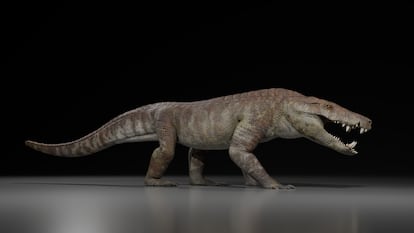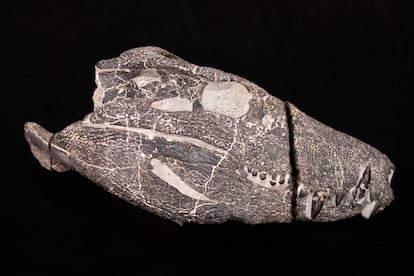The 'ferocious crocodile' that devoured dinosaurs in Patagonia 70 million years ago


Its appearance was terrifying. A head half a meter long, a voluminous snout, sharp, knife-like teeth, a body three meters long and weighing 250 kilograms. The atrocious Kostensuchus lived 70 million years ago in South America. Now, the skull, jaws, and multiple body bones of one of these predators—evolutionary relatives of modern crocodiles , but not ancestors—have been found fossilized and intact in Chorrillo, a geological formation that originated at the end of the Cretaceous in what is now Patagonia, southern Argentina. The new species is presented to the world this Wednesday in a study published in the journal PLOS One .
“Its scientific name could be translated as the ferocious crocodile of the wind ,” explains Fernando Novas, co-author of the article. This researcher from the National Scientific and Technical Research Council of Argentina (Conicet) at the Félix de Azara Foundation, clarifies that while today the Patagonia region is characterized by low temperatures, heavy snowfall, and a never-ending wind, when Kostensuchus inhabited it, it was a warm and humid landscape. Those freshwater alluvial plains were home to a wide variety of creatures, including dinosaurs, turtles, frogs, and mammals.
Kostensuchus belongs to the peirosaurids, a completely extinct family of crocodyliform reptiles that evolved mostly in South America and Africa. Its evolutionary lineage was a cousin of the eusuchians, from which modern crocodiles are descended. Thanks to the analysis of its cranial features, researchers have concluded that they were terrestrial animals. While the heads of modern Nile crocodiles and alligators are flattened—with bulging eyes facing upward and nostrils on the back of the snout, allowing them to glide unseen on the surface of the water—in Kostensuchus and its relatives, the heads were tall, the eyes pointed outward, and the nostrils pointed forward.

"It's very likely that they roamed inland, far from rivers and lagoons, and that they obtained food by hunting with short but fast runs," Novas explains. Kostensuchus 's legs were positioned vertically under its body, meaning they didn't crawl while walking or running, which represents another clear difference from the crocodile family. Its favorite prey is believed to have been the herbivorous dinosaur Isasicursor .
A story between two continentsThe first fossil remains of peirosaurids were found in Cretaceous rocks in Brazil, a few kilometers from Rio de Janeiro. Over the years, remains of these reptiles also began to be documented in Argentina, Morocco, and other regions of Africa, indicating that their dispersion was widespread across both continents. “The evolutionary history of these animals in South America was splendid, and they had a large number of representatives that are astonishing in their variety and adaptations. In other words, dinosaurs were not alone, but rather in the company of crocodiles ,” the author comments.
The evolutionary history of Kostesuchus also speaks to a shared history between South America and Africa over millions of years, when they were united into a single megacontinent, Gondwana. “Since they remained together for much of the Mesozoic Era, it's logical to expect that both plants and animals could have dispersed across both continental masses before the opening of the Atlantic Ocean,” Novas explains.
The Argentine paleontologist adds that " these discoveries we've been making in southern Patagonia may perhaps clarify the sequence of biological connections that have occurred over time between continents that are now so far apart." His scientific work continues because Novas is convinced that there are still new species to be discovered, hidden in Patagonian sediments. "And we have to go out and find them!" he exclaims.
EL PAÍS





